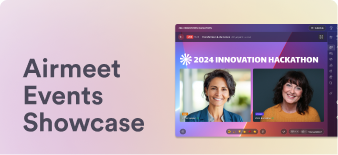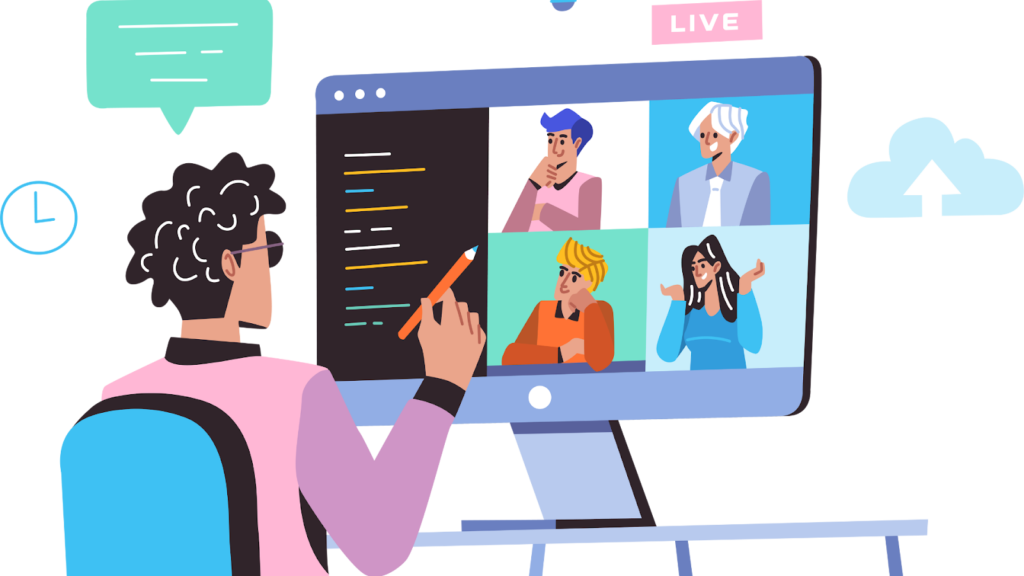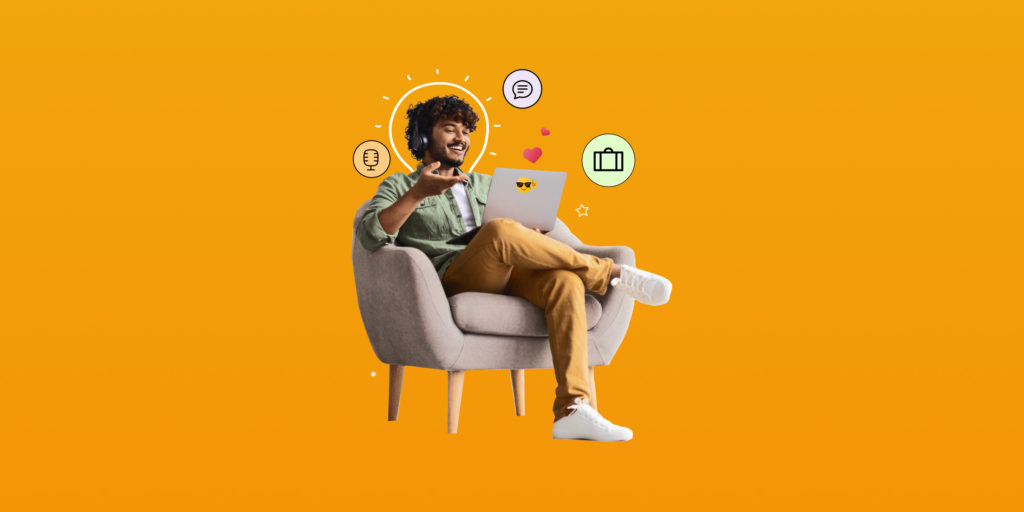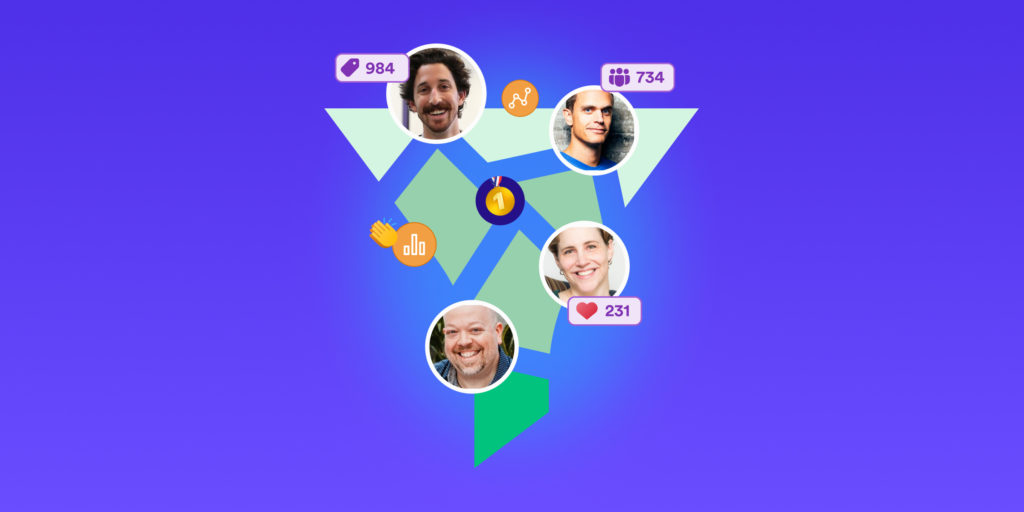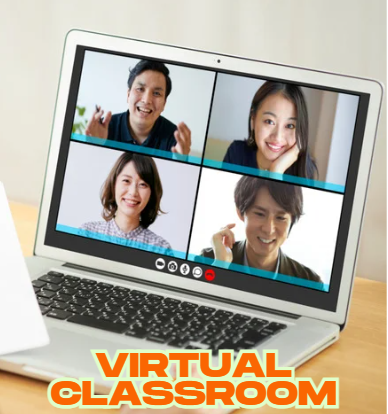
The key distinction of a virtual classroom is that it takes place in a live, synchronous setting, which facilitates real-time interaction and immediate feedback between instructors and students.
In fact, online learning is the fastest-growing market in the education industry – it has grown 900% since its creation in 2000. And in 2022, the online learning industry of the US market was worth $100 billion, which makes it the largest in the world. Research estimates that at this rate, it will grow to $686.9 billion by the year 2030.
In this guide, we will explore all you need to know about virtual classrooms, including their definition, benefits, history, key components, innovative virtual classroom ideas to engage students, the best platform to host an online classroom, and more.
What is a Virtual Classroom?

A virtual classroom is a digital space where students gather to gain insights about a particular subject from teachers. It facilitates real-time interaction and communication among students and the instructor, replicating the experience of a physical classroom.
Such online learning sessions are held by a video conferencing platform that allows teachers to deliver their presentation, share material & assignments, and engage with students virtually.
During a live session, students can even ask relevant questions regarding the topic, present their unique ideas, share unique viewpoints, be a part of the discussion, as well as collaborate with other learners.
How has the Virtual Classroom Evolved?

The idea of the virtual classroom was born in the 1960s when computer-assisted instruction (CAI) began to enter the educational field. At that time, CAI was limited to standalone computers delivering pre-programmed lessons.
A few years later, the concept of the virtual classroom gained traction with the emergence of computer networks in the 1970s, when professors and teachers began to utilize email to share assignments and communicate with students.
Back in the early 2000s, video conferencing technology took off as internet connection speeds and video codecs got enhanced. This helped to develop virtual classrooms that resembled traditional in-person classes, with live video interaction between teachers and students. Further, the technology advanced significantly in the early 2010s, leading to a growing adoption of virtual classrooms.
Today, we are delivering immersive, informative, and engaging classroom experiences through video conferencing platforms and making learning flexible and accessible to students across the globe. Various features like digital whiteboards, screen sharing, breakout rooms, gamification, Q&A, live polls, and real-time chat have made the online classroom more interactive and informative than ever before.
Moreover, Augmented Reality (AR) and Virtual Reality (VR) technology are beginning to enter the world of education and e-learning, offering the ability to create an immersive environment in a virtual classroom, making virtual learning exciting and memorable.
Another emerging trend in virtual classrooms is AI personalized learning that tailors the training experience based on students’ needs and preferences. It analyzes students’ past data, such as their performance, engagement, and learning style, and then recommends content so they can get the most out of it.
Hybrid classrooms will be seen in the future, bringing students from both worlds together, i.e., online and in-person, to provide a broader learning experience. As technological advancements continue, we will see more innovative developments in the field of education in the coming years, allowing students around the world to experience high-quality education in virtual classrooms.
Benefits of a Virtual Classroom

Benefits to the Instructor
Reach Global Students
A virtual learning session is conducted through a video conferencing platform that overcomes geographical barriers and allows students from different locations and time zones to attend class, thus giving teachers easy access to a global student pool.
Through virtual learning sessions, students can join from anywhere in the world and participate in live or asynchronous lessons, allowing teachers to train global students from the comfort of their homes.
Flexibility in Coaching
With the advent of virtual classrooms, teachers are no longer tied to physical classrooms. Thanks to the virtual classroom, teachers are now able to take live sessions and instruct their students from anywhere in the world.
With a stable internet connection and a laptop, instructors can deliver interactive lessons from their home, cafe, training center, or co-working space, regardless of class size.
Access to Digital Tools
Teachers have access to a variety of tools, including virtual whiteboards, screen sharing, Q&A, live chat, real-time polls, breakout rooms, and gamification, ensuring not just an informative session but also an engaging one. Also, they can collect real-time feedback from students to learn about their presentation performance and identify areas for improvement.
With Learning Management Systems (LMS) (e.g., Google Classroom, Moodle, TalentLMS, Blackboard), teachers can easily distribute content, collect assignments, track student progress, and deliver various educational content.
According to a study, 77% of higher education faculty agree or strongly agree that the LMS is critical to their teaching. 73% believe the LMS is a critical tool to enhance student learning. LMS actually helps teachers simplify administrative tasks and keeps all the students’ educational data in one place.
Benefits to Students
Flexibility and Accessibility
With an internet connection, students can attend the classroom from their home, park, coffee shop, or even while traveling by public transportation and interact with instructors, engage with content, and participate in classroom activities.
Thanks to virtual classrooms, students can learn in environments that best suit their learning styles, allowing them to focus better and retain information with ease.
Opportunity for Self-paced Learning
Many virtual classrooms involve asynchronous learning, which means the lessons are pre-recorded and available around the clock. This allows students to learn at their own pace and on their own schedule.
Asynchronous learning is really beneficial for those who are upgrading themselves while holding down a job, like individuals trying to complete their education while taking care of family responsibilities, and students in different time zones.
Builds a Network with Global Instructors and Learners
Virtual classrooms allow students from all over the world to attend live learning classes, opening the door for every student to connect with peers globally. At an online training session, students from different countries, cultures, and backgrounds can take part, which gives them the opportunity to build connections with each other.
Furthermore, by learning in an online classroom, students can interact with global teachers who can offer advice on securing a job in other countries, like the United States, Canada, and more.
Key Components of a Virtual Classroom

Interactive Virtual Whiteboard
Virtual whiteboards play a significant role in online classroom learning. It allows the instructor to type, write, annotate, and illustrate, to engage the students. Many professors use whiteboards to create mind maps, which help learners understand new concepts and complex topics easily.
Using a digital whiteboard, teachers can embed videos, images, and PDFs directly on the whiteboard to make the lessons more visually appealing, dynamic, and engaging. In addition to this, teachers can allow students to write and draw directly on the whiteboard using styluses.
Digital Content
When it comes to teaching in a remote classroom, digital content really serves as the core element of online learning. Presentation slides like PowerPoint or Google Slides, an ebook, infographics, charts, graphs, and videos are often used to instruct, educate, and engage the audience.
With a mix of multimedia content, teachers may deliver informative, useful, and engaging training sessions that truly stand out.
Virtual Classroom Platform
Virtual classroom platforms create a comprehensive and interactive environment, making them an essential component of online classroom training. It offers numerous features such as live HD streaming, screen sharing, interactive virtual stage, live chat, real-time poll, Q&A, breakout room, and networking to make lessons engaging and provide students with a high-quality learning experience.
An online classroom platform allows you to upload, store, and share various digital content with students, like PDF documents, presentation slides, videos, audio files, external links, and much more.
The software automatically records the live session so you can share the recording with students who missed the live lecture, allowing them to learn at their own pace.
Learning Management System (LMS)
This serves as the central hub of the virtual classroom. It’s a software platform that facilitates the administration task, documentation, reporting, and delivery of educational courses or training programs.
Plus, it tracks student progress, performance, and engagement throughout the course. Through an LMS, teachers can also automate tasks such as quizzes, assignments, or reminders for students.
5 Creative Ideas to Make an Online Classroom Engaging
Whether you have a small or large group of students in your virtual classroom, it is critical to maintain student engagement and keep them fully involved throughout the session. Online learning sessions are typically packed with distractions, so incorporating some creative activities into your lectures will help students maintain their focus throughout the session.
The following ideas will make your next virtual learning classroom engaging and memorable.
1) Start the Session with an Icebreaker

It is an amazing idea to begin the classroom with an icebreaker activity. This will help students mingle, lighten their mood, and make them feel comfortable in an online learning environment. A good icebreaker can set the tone, engage learners from the start, and transform an ordinary training session into an engaging one.
You can incorporate various icebreaker exercises such as “would you rather”, “two truth and a lie”, “charades”, “show and tell”, “scavenger hunt”, “emoji guessing”, and “pictionary”. Students’ participation in your live lecture will be boosted, thanks to all of these icebreaker activities.
2) Incorporate Games
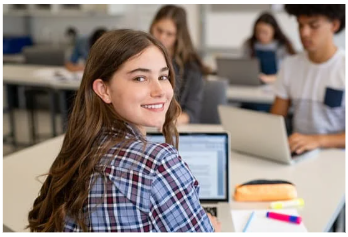
Incorporating games into your online learning session is a great way to add some fun, capture students’ attention, and bring excitement into your classroom. Games are full of challenges and thrilling obstacles that require critical thinking, strategic planning, and creative solutions, which will directly help develop students’ problem-solving abilities.
Consider including games that challenge the students, like “escape room”, “treasure hunt”, “mind mapping”, “vision board”, and “puzzle bonanza”. All of these games can help develop students’ critical thinking and problem-solving skills.
3) Conduct an Ask Me Anything (AMA) Session

It’s an amazing idea to keep an Ask Me Anything (AMA) Session at your next virtual classroom, as it can allow your students to ask direct questions and find the answers they were seeking.
Allow students to pose questions on specific topics, such as career development, time management, study habits, stress management, and more. And ask students to submit questions in advance so that you have their answers ready.
4) Allow Students to Network with Each Other

Encourage your online classroom students to network with one another. Students will have the same experience as they would in a real classroom, where they can interact with students next to them and speak freely. If your training session involves global students, they can build connections with students in other countries, broadening their international network.
In networking sessions, students can learn from each other’s perspectives, discuss any parts of the topic they are unsure of, and strengthen their grasp of the concept.
5) Leverage Breakout Rooms

In order to make your virtual students more active and involved in the session, conduct an interactive breakout room during a virtual classroom.
This feature allows you to divide students into smaller groups where they can talk freely, ask questions, share ideas, learn from other learners, and have more intimate discussions about a subject.
For the best results, schedule the breakout room session after you’ve taught your main topic, so they can have a deeper debate about it.
Which Video Conferencing Platform is Best for Hosting Virtual Classrooms, and Why?
Airmeet is the best video conferencing tool for virtual classrooms.
It focuses on creating an interactive and engaging environment in a virtual classroom. It offers a comprehensive suite of features that replicates the experience of in-person learning.
Airmeet provides dedicated tools and features to deliver impactful lessons, such as an interactive virtual stage, HD live streaming capabilities, student engagement tools like chat, polls, and Q&A, breakout rooms, advanced networking tools, gamification, and cloud recording.
Airmeet is committed to data privacy and security, which helps create a safe learning environment for your classroom. Since Airmeet focuses on creating immersive and engaging virtual events, it is truly a great platform to give your students a memorable learning experience.
Final Thoughts
A virtual classroom allows teachers and students to gather remotely and use digital tools like a video conferencing platform, live video chat, interactive virtual whiteboard to interact, communicate, and engage with each other in real-time.
In fact, an online classroom replicates the experience of an in-person classroom, which not only fosters real-time interaction but also creates a dynamic learning environment. It removes the geographical barriers, allowing different time zones students to attend the classroom and gain academic knowledge from instructors, tutors, and professors.
Thanks to the virtual classroom, students and teachers no longer need to travel. With a strong internet connection, teachers can train worldwide learners, and students can attend lectures from any place, such as their homes, coffee shops, and other locations.
Frequently asked questions
- A virtual classroom is a completely online environment where students and teachers interact, communicate, and engage remotely, usually via a video streaming platform.
- A physical classroom takes place in a physical room, like a training center or seminar room, where all students can see and learn from their instructors in person.
- A hybrid classroom combines both worlds of people, with some students attending in person and some participating virtually.
The role of the teacher is to educate students, sharing the knowledge they know and enhancing their understanding of a particular topic. They deliver engaging lessons as well as ensure the curriculum is effectively taught and completed on time. In fact, the work of an online teacher is multifaceted, and they guide students as a mentor, advisor, and friend. In an online classroom, tutors create a supportive environment and encourage students to ask questions, clarify doubts, and address their concerns related to concepts.

